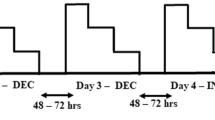Abstract
Ten male subjects performed five maximal treadmill running tests at 7 mph. Tests included two (test-retest) progressive, step increment (2 1/2% grade elevation), discontinuous tests (DCT); a progressive, step increment, continuous test (CT) and two constant load tests (CL and CL + 2 1/2%). A DCT test was performed first for establishment of peak elevation levels as constant load tests were performed at the peak elevation level attained (CL) and at a level 2 1/2% higher (CL + 2 1/2%). The second DCT test and the remaining three tests were administered randomly. Peak performance capability (operationally defined as duration at highest grade elevation) was markedly reduced during progressive tests as compared with constant load tests. There was a similar reduction in peak performance capability during the CT test as compared with the DCT test. Maximal oxygen uptake (VO2max) was quite similar among the various tests. It was concluded thatVO2max attained during progressive, step increment, tests is unaffected by cumulative submaximal work. Discontinuous and continuous progressive tests provide similarVO2max results.
Similar content being viewed by others
References
åstrand, P. O., Saltin, B.: Oxygen uptake during the first minutes of heavy muscular exercise. J. appl. Physiol.16, 971–976 (1961)
åstrand, P. O.: Measurement of maximal aerobic capacity. Canad. med. Ass. J.96, 732–735 (1967)
Davies, C. T. M., Tuxworth, W., Young, J. W.: Physiological effects of repeated exercise. Clin. Sci.39, 247–258 (1970)
Faulkner, J. A., Roberts, D. E., Elk, R. L., Conway, J.: Cardiovascular responses to submaximum and maximum effort cycling and running. J. appl. Physiol.30, 457–461 (1971)
Hermansen, L., Saltin, B.: Oxygen uptake during maximal treadmill and bicycle exercise. J. appl. Physiol.26, 31–37 (1969)
Horvath, S. M., Michael, E. D., Jr.: Responses of young women to gradually increasing and constant load maximal exercise. Med. Sci. Sports3, 128–131 (1970)
Maksud, M. G., Coutts, K. D.: Comparison of a continuous and discontinuous graded treadmill test for maximal oxygen uptake. Med. Sci. Sports3, 63–65 (1971)
McArdle, W. D., Katch, F. I., Pechar, G. S.: Comparison of continuous and discontinuous treadmill and bicycle tests for maxVO2. Med. Sci. Sports5, 156–160 (1973)
Mitchell, J., Sproule, B., Chapman, C.: The physiological meaning of the maximal oxygen intake test. J. clin. Invest.37, 538–546 (1958)
Newton, J. L.: The assessment of maximal oxygen intake. J. Sport. Med. (Torino)3, 164–169 (1963)
Shephard, R. J., Allen, C., Banade, A. J. S., Davies, C. T. M., de Prampero, P. E., Hedman, R., Merriman, J. E., Myhre, K., Simmins, R. S.: The maximum oxygen intake. An international reference standard of cardiorespiratory fitness. Bull. Wld. Hlth Org.38, 757–764 (1968)
Stamford, B. A.: Maximal oxygen uptake during treadmill walking and running at various speeds. J. appl. Physiol.39, 386–389 (1975)
Taylor, H. L., Buskirk, E. R., Henschel, A.: Maximal oxygen intake as an objective measure of cardiorespiratory performance. J. appl. Physiol.8, 73–80 (1955)
Author information
Authors and Affiliations
Additional information
This research was partially supported by a grant from the College of Arts and Sciences, University of Louisville (1974-2)
Rights and permissions
About this article
Cite this article
Stamford, B.A. Step increment versus constant load tests for determination of maximal oxygen uptake. Europ. J. Appl. Physiol. 35, 89–93 (1976). https://doi.org/10.1007/BF02333798
Received:
Issue Date:
DOI: https://doi.org/10.1007/BF02333798




